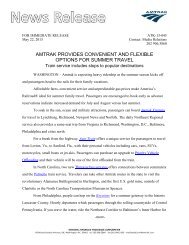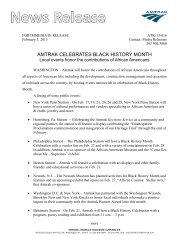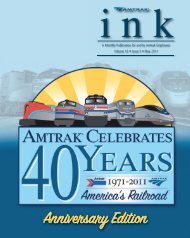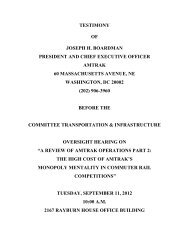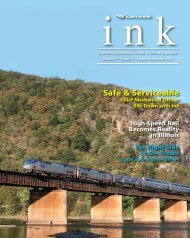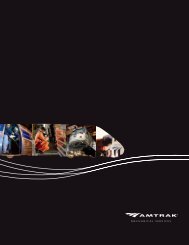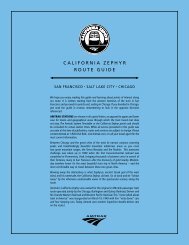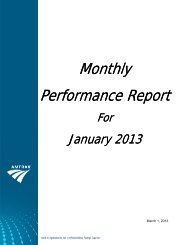Cross Border Passenger Rail Service Plan - Amtrak
Cross Border Passenger Rail Service Plan - Amtrak
Cross Border Passenger Rail Service Plan - Amtrak
You also want an ePaper? Increase the reach of your titles
YUMPU automatically turns print PDFs into web optimized ePapers that Google loves.
Report to the United States Congress<br />
Strategic <strong>Service</strong> and Security Proposal<br />
For <strong>Amtrak</strong> <strong>Service</strong> in Vancouver BC<br />
During (and Possibly After) the 2010 Winter Olympic Games<br />
<strong>Amtrak</strong> Cascades at Crescent Beach<br />
National <strong>Rail</strong>road <strong>Passenger</strong> Corporation October 2009
Contents<br />
Purpose and Approach 3<br />
Executive Summary 4<br />
Strategic <strong>Plan</strong> for Seattle – Vancouver <strong>Service</strong> 7<br />
Security Recommendations to the Department of Homeland Security 14<br />
Next Steps 25<br />
APPENDICES 26<br />
2
Purpose<br />
This report is submitted to Congress in compliance with provisions of Section 406 of the<br />
<strong>Passenger</strong> <strong>Rail</strong> Investment and Improvement Act of 2008. These provisions require<br />
<strong>Amtrak</strong> to:<br />
1. Develop a strategic plan to facilitate expanded passenger rail service across the<br />
international border between the United States and Canada during the 2010 Olympic<br />
Games on the <strong>Amtrak</strong> passenger rail route between Vancouver, British Columbia,<br />
Canada, and Eugene, Oregon (commonly known as “<strong>Amtrak</strong> Cascades”);<br />
2. Develop recommendations for the Department of Homeland Security to process<br />
efficiently rail passengers traveling on <strong>Amtrak</strong> Cascades across the international<br />
border during the 2010 Olympic Games; and<br />
3. Submit to Congress a report containing the strategic plan described in paragraph 1<br />
and the recommendations described in Paragraph 2.<br />
This report is due to Congress on October 16, 2009.<br />
Approach<br />
In preparing this report, <strong>Amtrak</strong> relied upon the results of previous studies and also<br />
obtained the input of other organizations.<br />
The strategic plan for train service is based upon a modification to the service<br />
inaugurated in August 2009 in partnership with the Washington State Department of<br />
Transportation. <strong>Amtrak</strong> is prepared to operate this service either through the period of<br />
the Olympics or on a permanent basis if funding continues to be available and potential<br />
obstacles are removed.<br />
In preparing recommendations for the Department of Homeland Security, <strong>Amtrak</strong><br />
sought advice, input and draft reviews from the Transportation Security Administration<br />
(TSA), U.S. Customs and <strong>Border</strong> Protection (USCBP), and the Canada <strong>Border</strong> <strong>Service</strong>s<br />
Agency (CBSA), in addition to local and <strong>Amtrak</strong> police. This phase was concluded with<br />
a joint meeting in Blaine, WA, for a review of the draft of proposed recommendations.<br />
All above agencies participated as well as staff members from the offices of Senators<br />
Maria Cantwell and Patty Murray and Representative Rick Larsen.<br />
The following report incorporates the results of these efforts.<br />
3
Expanded service<br />
Executive Summary<br />
<strong>Amtrak</strong> recommends that the two round trips per day now operated between Seattle,<br />
WA, and Vancouver, BC, be slightly modified for the period of the 2010 Olympic and<br />
Paralympic Games. The schedule change would be effective on or about February 1,<br />
2010 and revert to the normal pattern on or about March 31, 2010 (if the second round<br />
trip continues) giving those who wish to tour Canada before the Games or stay beyond<br />
them more benefit from this service. Specifically <strong>Amtrak</strong> recommends during the period<br />
of the Games altering the existing schedule of the southbound afternoon train to a 7:45<br />
PM departure, two hours later than normal. This would allow visitors to stay for the<br />
completion of more events.<br />
As of mid-August, <strong>Amtrak</strong> Cascades International service includes one daily round trip<br />
operating between Seattle, WA, and Vancouver, B.C. in the morning and returning from<br />
Vancouver, B.C. to Seattle, WA, in the early evening. It also includes a second round<br />
trip originating in Portland, OR in the afternoon and terminating in Vancouver later the<br />
same night, then returning from Vancouver to Portland early the following morning.<br />
Both trains make stops in both directions at intermediate stations.<br />
Prior to the inauguration of the second service in August, other options considered for<br />
Olympics service expansion included:<br />
Three round trips to and from Vancouver spaced throughout the day, and<br />
Two or three morning northbound and evening southbound trains “fleeted” to and<br />
from Vancouver for more passenger capacity.<br />
Midday trains, however, would have little appeal to travelers attending the Games since<br />
the trains would arrive and depart in the midst of the very activities in which everyone<br />
will be interested. Market analysis did not indicate enough demand for more capacity in<br />
the morning and evening time periods. In addition, the service now operated with the<br />
schedule modification can be operated with present resources. The other optional<br />
services would require one or two more train sets. Also, additional border security<br />
infrastructure at Pacific Central Station in Vancouver can be avoided if no more than<br />
one <strong>Amtrak</strong> train is in the station at any one time as recommended here. The secure<br />
fenced area will hold only one train. The optional services would have two or three<br />
trains there at some times. If three round trips were spaced throughout the day, the<br />
arrival of some trains would overlap the departure of others. If two or three trains were<br />
“fleeted” to and from Vancouver, all would be there at the same time. This would<br />
require rebuilding and expanding the fenced enclosure, and perhaps subdividing it, so<br />
that sequential trains could be worked individually in parallel.<br />
Recognizing the interest of the State of Washington and the market potential for regular<br />
twice daily service, <strong>Amtrak</strong> could operate the proposed service permanently after the<br />
Games are concluded provided funding remains available and continued customs and<br />
immigration services are provided by the Canadian <strong>Border</strong> <strong>Service</strong>s Agency without<br />
4
cost to <strong>Amtrak</strong> or WSDOT. In that event, <strong>Amtrak</strong> would return the evening southbound<br />
departure back to the current 5:45 PM following completion of the Games.<br />
Security Recommendations<br />
The U.S. Department of Transportation has designated Eugene, OR - Vancouver, BC<br />
as one of ten High Speed <strong>Rail</strong> Corridors in the United States. With an overall length of<br />
464 miles and a significant number of major on-line population centers, it is ideally<br />
suited for development. While the entire corridor is eligible for federal investment, this<br />
report addresses only the portion between Seattle, WA, and Vancouver, BC. <strong>Amtrak</strong><br />
believes that funding for security infrastructure improvements could be made available<br />
by the U.S. Congress perhaps because of its High Speed Corridor designation.<br />
Although there is considerable potential for a rail passenger market, the present <strong>Amtrak</strong><br />
Cascades service is not time-competitive with alternate modes. Map Quest estimates<br />
automobile driving time at 3:05. <strong>Amtrak</strong> thruway buses cover the route in 3:30. Flying<br />
time is 48 minutes plus inspections and access time to and from airports. The existing<br />
trains, however, take 3:55 northbound and 4:20 southbound for the 155 mile Seattle –<br />
Vancouver portion of the overall corridor.<br />
The incremental implementation of high-speed corridor service requires taking trip time<br />
out of schedules and eliminating delays. This can be accomplished, for example, by<br />
track realignments that reduce curvature or signal improvements to permit faster<br />
speeds. Another trip time reduction improvement possibility unique to this corridor<br />
would be conducting combined pre-clearance inspections of U.S. bound passengers at<br />
the Vancouver Pacific Central Station. Combined inspections would eliminate the<br />
current customs stop at the border and thus eliminate 15 minutes of daily delay typically<br />
experienced by trains entering the United States. Market studies show that timestanding-still<br />
is a major irritant to rail passengers.<br />
To facilitate this improvement, <strong>Amtrak</strong> offers the following conclusions and<br />
recommendations to the U.S. Congress and the Department of Homeland Security.<br />
1. The current combined customs and immigration process northbound into Canada<br />
requires no change other than facility improvements at Vancouver Pacific Central<br />
Station already under development and addressed later in this report. All these<br />
processes are performed by the Canadian <strong>Border</strong> <strong>Service</strong>s Agency at Vancouver<br />
Pacific Central Station.<br />
2. The current process for southbound trains to the U.S. results in delay to rail<br />
passengers. It is comprised of two-step USCBP immigration clearance at Vancouver<br />
followed by USCBP customs clearance at Blaine, WA. <strong>Amtrak</strong> recommends that this<br />
practice change to combined immigration and customs pre-clearance in Vancouver.<br />
This change could be made upon completion of physical facility improvements and<br />
authorization of additional staff required by USCBP for the added scope of work. This<br />
change would reduce the trip time of southbound trains by at least 15 minutes.<br />
5
3. <strong>Amtrak</strong> recommends that Congress provide $526,500 in funding for facility<br />
improvements at the jointly-controlled and used Immigrations and Customs space in<br />
Vancouver’s Pacific Central Station as identified in this report and/or as requested by<br />
the Department of Homeland Security and U.S. Customs and <strong>Border</strong> Protection.<br />
4. <strong>Amtrak</strong> recommends that the U.S. Congress provide funding for the additional<br />
USCBP personnel needed to perform these combined and expanded duties at Pacific<br />
Central Station as specified by USCBP and the Department of Homeland Security.<br />
5. <strong>Amtrak</strong> recommends that the U.S. Congress request the Department of State to ask<br />
that the Government of Canada consider amending the Canadian Pre-Clearance Act of<br />
June 17, 1999 to extend the protections of this Act currently covering USCBP officers<br />
performing pre-clearance activities at certain airports to selected rail and sea ports as<br />
well.<br />
6. <strong>Amtrak</strong> noted that it has no current process to match a traveler’s passport name with<br />
the name used on the rail ticket. It therefore recommends instituting a name match<br />
(cross reference) of immigration documentation during the ticketing process to ensure<br />
the same name appears on the <strong>Amtrak</strong> ticket.<br />
6
Background<br />
Part 1 - Strategic <strong>Plan</strong> for Expanded Seattle – Vancouver <strong>Service</strong><br />
<strong>Amtrak</strong> began operation of the Seattle – Vancouver service as one of the first additions<br />
to its original national system network on July 17, 1972. Due largely to poor on-time<br />
performance caused by customs and immigration related delay, the service was<br />
discontinued in 1981. Subsequent to discontinuance, the United States Department of<br />
Transportation in 1992 designated the Pacific Northwest <strong>Rail</strong> Corridor (Vancouver, BC –<br />
Eugene, OR) as one of the (then) five high-speed rail corridors in the country.<br />
In May 1995, <strong>Amtrak</strong> and the Washington State Department of Transportation<br />
(WSDOT) reintroduced rail service between Seattle, WA, and Vancouver, BC. Unique<br />
to this <strong>Amtrak</strong> cross border service, the majority of inspection activities in both directions<br />
now take place in Pacific Central Station in Vancouver, BC. The Agency currently<br />
performing inspection activities at the border is USCBP. Initially this inspection was<br />
performed by the U.S. Customs Agency and was conducted on-board enroute between<br />
Blaine, WA and Bellingham, WA. U.S. Customs officers then returned to Blaine, WA,<br />
via automobile. Subsequent to September 11, 2001, the agency required <strong>Amtrak</strong> to<br />
stop at the border at Blaine, WA in order for it to perform this inspection. The related<br />
delay is approximately 15 minutes.<br />
In September 1999, <strong>Amtrak</strong> and WSDOT began operation of an additional Seattle, WA -<br />
Bellingham, WA service. Connecting bus service between Bellingham and Vancouver<br />
was operated until May 31, 2001 but was discontinued due to poor ridership. Other<br />
Thruway Bus <strong>Service</strong> continues to operate in similar time periods between Seattle and<br />
Vancouver but does not connect with trains at Bellingham.<br />
In early 2008, WSDOT asked <strong>Amtrak</strong> to extend the Bellingham, WA, train service to<br />
Vancouver, BC. <strong>Amtrak</strong> prepared plans and financial estimates to implement the<br />
service. It hired and trained the required additional staff and was fully prepared for<br />
inauguration in mid-August 2008. Due to a requirement by the Canadian <strong>Border</strong><br />
<strong>Service</strong>s Agency for a payment of $1500.00 per day to process passengers from the<br />
second train, however, the service was not implemented. That cost would have added<br />
more than $500,000 per year to the projected operating deficit. The State of<br />
Washington was not able to pay that added cost. That impasse has now been resolved<br />
through March 2010.<br />
Ridership on the entire Cascades Corridor service was 94,000 in Fiscal Year 1993 and<br />
increased to more than 774,000 in Fiscal Year 2008. Included in that was ridership to<br />
and from Vancouver of more than 66,000 in Fiscal Year 2008.<br />
Cascades Corridor<br />
The Pacific Northwest Cascades Corridor as designated by the U.S. Department of<br />
Transportation extends 464 miles from Vancouver, B.C. to Eugene, OR. Fourteen<br />
7
intermediate communities are served daily by as many as five trains operated in each<br />
direction. One of these trains is <strong>Amtrak</strong>’s Coast Starlight which travels between Seattle<br />
and Los Angeles. The largest intermediate cities served are Seattle, WA, and Portland,<br />
OR. Other stations served are: Albany, OR, Salem, OR, Oregon City, OR, Vancouver,<br />
WA, Kelso, WA, Centralia, WA, Olympia, WA, Tacoma, WA, Tukwila, WA, Edmonds,<br />
WA, Everett, WA, Mt. Vernon, WA, and Bellingham, WA. <strong>Service</strong> to Stanwood, WA, will<br />
begin in the fall of 2009.<br />
While the general route is an excellent candidate for development into a high-speed<br />
corridor, sections of the current right of way are not configured for speed. Much of the<br />
railroad between Seattle, WA, and Vancouver, BC, was built on a “shelf” carved out of a<br />
mountainside adjacent to Puget Sound. Consequently, the railroad follows the profile of<br />
the shoreline where the mountains meet the water resulting in almost continual<br />
curvature. The route is also characterized by several movable bridges (i.e.,<br />
drawbridges) with severe speed restrictions. Transit through the Vancouver<br />
Metropolitan Area and into Pacific Central Station is slow.<br />
Most of the route, however, is characterized by beautiful scenery. Even if consistent<br />
true high-speed service cannot be achieved in the near future, the online population,<br />
tourist attractions, scenic views, greater frequency of service and reliable moderate trip<br />
time improvement would probably improve commercial viability.<br />
Future incremental right of way development might take the form of speed increases<br />
perhaps on dedicated segments of passenger high speed track where the right of way<br />
would be tangent. It could also include replacement of movable bridges with high level<br />
fixed spans not requiring speed restrictions. Significant new investment would be<br />
essential.<br />
Train Schedules – Current, Proposed Olympics, and Potential Long Term<br />
Beginning in early August, service between Seattle and Vancouver now includes two<br />
daily round trips through March 2010. The first is the long standing daylight round trip<br />
that departs Seattle at 7:40 AM and arrives in Vancouver at 11:35 AM. This train makes<br />
intermediate stops at Edmonds, Everett, Mount Vernon and Bellingham. <strong>Service</strong> to<br />
Stanwood will be added in the fall of 2009. The return service departs Vancouver at<br />
5:45 PM and arrives in Seattle at 10:05 PM, making the same intermediate stops. The<br />
second round trip, initiated in early August, departs Portland at 2:50 PM, Seattle at 6:50<br />
PM and arrives in Vancouver at 10:45 PM. It departs Vancouver at 6:40 AM with<br />
arrivals at Seattle and Portland at 11:00 AM and 2:55 PM respectively. The current<br />
timetable follows.<br />
8
Vancouver BC – Seattle, WA – Portland, OR<br />
DAILY SCHEDULES<br />
Effective August 2009<br />
TRAIN TRAIN TRAIN TRAIN TRAIN TRAIN TRAIN TRAIN<br />
501 513 507 517 506 516 508 510<br />
DAILY DAILY DAILY DAILY DAILY DAILY DAILY DAILY<br />
DP 6:40 A 5:45 P VANCOUVER, BC AR 10:45 P 11:35 A<br />
8:35 A 7:40 P BELLINGHAM, WA 8:53 P 9:44 A<br />
9:05 A 8:12 P MOUNT VERNON 8:24 P 9:13 A<br />
9:57 A 8:54 P EVERETT 7:42 P 8:31 A<br />
10:22 A 9:19 P EDMONDS 7:17 P 8:07 A<br />
AR 11:00 A 10:05 P SEATTLE DP 6:50 P 7:40 A<br />
DP 7:30 A 11:25 A 2:20 P SEATTLE AR 3:55 P 6:20 P 9:45 P<br />
7:45 A 11:40 A 2:35 P TUKWILA 3:11 P 5:46 P 9:11 P<br />
8:15 A 12:10 P 3:05 P TACOMA 2:41 P 5:16 P 8:41 P<br />
8:54 A 12:49 P 3:44 P OLYMPIA-LACEY 2:03 P 4:38 P 8:03 P<br />
9:16 A 1:08 P 4:03 P CENTRALIA 1:42 P 4:17 P 7:42 P<br />
9:54 A 1:49 P 4:44 P KELSO-LONGVIEW 1:03 P 3:38 P 7:03 P<br />
10:29 A 2:24 P 5:19 P VANCOUVER, WA 12:30 P 3:05 P 6:30 P<br />
AR 11:00 A 2:55 P 5:50 P PORTLAND, OR DP 12:15 P 2:50 P 6:15 P<br />
Footnote: Trains 513 and 517 depart Vancouver, BC 15 minutes after the published<br />
times to ensure adequate inspection times.<br />
During the period of the Olympics, beginning in early February 1 and concluding in late<br />
March, <strong>Amtrak</strong> recommends making only one change to this schedule. That revision<br />
would be to move the departure of evening southbound Train 517 to depart Vancouver<br />
two hours later at 7:45 PM instead of 5:45 PM. The later departure would allow<br />
passengers to attend Olympic events later than would be possible if the current<br />
schedule continued to operate. The proposed detailed Olympics <strong>Service</strong> Timetable<br />
follows.<br />
9
DAILY SCHEDULES<br />
Effective During 2010 Olympic and Paralympic Games<br />
TRAIN TRAIN TRAIN TRAIN TRAIN TRAIN TRAIN TRAIN<br />
501 513 507 517 506 516 508 510<br />
DAILY DAILY DAILY DAILY DAILY DAILY DAILY DAILY<br />
DP 6:40 A 7:45 P VANCOUVER, BC AR 10:45 P 11:35 A<br />
8:35 A 9:40 P BELLINGHAM, WA 8:53 P 9:44 A<br />
9:05 A 10:12 P MOUNT VERNON 8:24 P 9:13 A<br />
9:57 A 10:54 P EVERETT 7:42 P 8:31 A<br />
10:22 A 11:19 P EDMONDS 7:17 P 8:07 A<br />
AR 11:00 A 12:05 A SEATTLE DP 6:50 P 7:40 A<br />
DP 7:30 A 11:25 A 2:20 P SEATTLE AR 3:55 P 6:20 P 9:45 P<br />
7:45 A 11:40 A 2:35 P TUKWILA 3:11 P 5:46 P 9:11 P<br />
8:15 A 12:10 P 3:05 P TACOMA 2:41 P 5:16 P 8:41 P<br />
8:54 A 12:49 P 3:44 P OLYMPIA-LACEY 2:03 P 4:38 P 8:03 P<br />
9:16 A 1:08 P 4:03 P CENTRALIA 1:42 P 4:17 P 7:42 P<br />
9:54 A 1:49 P 4:44 P KELSO-LONGVIEW 1:03 P 3:38 P 7:03 P<br />
10:29 A 2:24 P 5:19 P VANCOUVER, WA 12:30 P 3:05 P 6:30 P<br />
AR 11:00 A 2:55 P 5:50 P PORTLAND, OR DP 12:15 P 2:50 P 6:15 P<br />
Footnote: Trains 513 and 517 depart Vancouver, BC 15 minutes after the published<br />
times to ensure adequate inspection times.<br />
Finally, if the trial service to be operated through March 2010 proves to be successful<br />
and the Canadian <strong>Border</strong> <strong>Service</strong>s Agency agrees to continue the services that it will<br />
provide during the trial period on a permanent basis, the timetable will revert to the one<br />
being operated as of now. Market studies have shown that ridership and revenue would<br />
be significantly better on an annual basis if these trains operate in these normal time<br />
slots rather than Olympic time slots except during the period of the Games.<br />
Equipment utilization and maintenance<br />
In 1999, <strong>Amtrak</strong> and WSDOT purchased four Talgo custom built tilt trains. In 2003,<br />
WSDOT purchased another set bringing the <strong>Amtrak</strong> and WSDOT total to five.<br />
Ordinarily these five train sets are used to operate the entire <strong>Amtrak</strong> Cascades Corridor<br />
service between Eugene OR and Vancouver BC. One set is typically deployed on the<br />
daily daylight round trip of Train 510 and Train 517 between Seattle and Vancouver.<br />
10
The other four sets cover all other services and ordinarily operate on a four day cycle of<br />
consecutive trains before repeating the pattern. This pattern includes the other round<br />
trip to and from Vancouver with the late evening arrival from and early morning<br />
departure to Seattle and Portland.<br />
All car maintenance other than simple turnaround servicing and daily inspection is done<br />
in Seattle by the train manufacturer, Talgo, using <strong>Amtrak</strong>’s skilled workforce. All<br />
equipment must periodically cycle in and out of the Seattle maintenance facility for more<br />
significant levels of maintenance. Talgo’s procedures address all maintenance<br />
requirements in rotation so that no train set is out of service except during overhaul.<br />
Recently, due to such an ongoing overhaul program, the Vancouver trains were<br />
operated with Superliner equipment including a locomotive, baggage coach, diner-<br />
lounge and coach. The recently added service to and from Vancouver did not require<br />
any additional equipment. Its former Bellingham turnaround point was merely moved to<br />
Vancouver. Related cleaning and minor maintenance work performed at Bellingham<br />
overnight was likewise moved to Vancouver to be performed during the layover.<br />
Ridership and Revenue<br />
Ridership and revenue forecasts prepared for <strong>Amtrak</strong> indicate that the second daily<br />
round trip, if operated on a year-round basis, will add 60,000 riders and $2,300,000 in<br />
revenue compared to current service. A further increment of 10,000 riders and<br />
$380,000 in revenue are expected during the period of the Olympics due to the<br />
temporarily revised schedule to accommodate those attending the events. The<br />
complete ridership and revenue forecast is included as Appendix A.<br />
Forecasted financial results – Olympics and Annualized Normal <strong>Service</strong><br />
As shown in the table below, either service operated just during the period of the<br />
Olympics or year-round service (in a typical year), if added incrementally to the existing<br />
Cascades Corridor service, would substantially increase revenue and recover about<br />
two-thirds of related operating expenses from fare box revenues. <strong>Service</strong> during the<br />
Olympics would bring in $400,000 in additional revenue and incur operating costs of<br />
approximately $600,000 and have a resulting deficit of $200,000. Annual service in a<br />
normal time period would bring in added revenues of $2.3 million, incur expenses of<br />
$3.3 million and have a resulting loss of about $1.0 million.<br />
An important distinction between these two time periods is that police and security costs<br />
would be higher during the Olympics due to the added cost of redeploying staff from<br />
other locations to address a potentially higher threat level. In particular this would<br />
include travel and away from home expenses of meals and hotels.<br />
11
Summary of Financial Results<br />
Olympic Period<br />
Riders 10,000<br />
Annual<br />
60,000<br />
Revenue $0.4 million $2.3 million<br />
Direct and Shared Costs<br />
Transportation $0.1 million $0.7 million<br />
On-Board <strong>Service</strong> $0.1 million $0.8 million<br />
Maintenance of<br />
Equipment<br />
$0.1 million $0.4 million<br />
Stations $0.1 million $0.7 million<br />
RSO, Marketing & Sales $0.1 million $0.3 million<br />
Police/Environmental<br />
and Safety<br />
$73,000 (1) $16,000<br />
Other $50,000 $0.3 million<br />
Total Direct and Shared<br />
Costs<br />
$0.6 million $3.3 million<br />
Net Impact -$0.2 million -$1.0 million<br />
1. Olympic estimate includes $70,000 for travel and lodging for security team.<br />
2. The complete P&L is included as Appendix B.<br />
Capital Investments<br />
In addition to the initial purchase of train sets by <strong>Amtrak</strong> and WSDOT, capital<br />
investments have been made (primarily funded by WSDOT) to the infrastructure<br />
between Vancouver BC and Edmonds, WA. A brief summary is shown below:<br />
Stations: Vancouver, BC - Facility security improvements were completed for the<br />
reintroduction of rail service in May 1995. These improvements allow for<br />
the inspection of passengers at the Pacific Central Station by Canadian<br />
Customs and Immigration agencies as well as by the USCBP immigration<br />
personnel.<br />
Bellingham, WA – A renovated station located in Fairhaven section was<br />
opened in 1995.<br />
Mt Vernon, WA – The former facility located at College Street was<br />
abandoned and replaced by the newly constructed Skagit Transportation<br />
Center in 2004.<br />
12
Everett, WA – The former station at Bond Street was abandoned and<br />
replaced by the newly constructed Everett Station in 2002.<br />
Stanwood, WA – <strong>Service</strong> will begin at a newly constructed station<br />
during the fall of 2009<br />
Investments have also been made in the BNSF right of way between Vancouver, BC,<br />
and Edmonds, WA, to increase capacity and advance the state of good repair. These<br />
improvements include the lengthening of passing sidings along this single track rail line<br />
at Mt. Vernon, WA, and Colebrook, BC. In addition, improved rail was installed in the<br />
vicinity of Chuckanut, WA.<br />
Continued permanent service<br />
<strong>Amtrak</strong> is prepared to operate two round trips per day to and from Vancouver, BC, on a<br />
permanent basis following the Olympic and Paralympics Games. For this to be<br />
realized, the Canadian government will need to find the service during the trial period<br />
through March 2010 to be worth continued CBSA support at no cost to <strong>Amtrak</strong> or<br />
WSDOT. Similarly, WSDOT will need to provide continued financial support as it has<br />
consistently done for many years for the entire <strong>Amtrak</strong> Cascades service. It would be<br />
helpful for <strong>Amtrak</strong> to know those respective government decisions one month prior to<br />
March 31, 2010 since planned employee utilization and job postings will hinge on<br />
whether the second round trip will continue beyond that date.<br />
13
Part 2 - Security Recommendations to the Department of Homeland Security<br />
Methodology<br />
To prepare a recommendation for more efficient processing of rail passengers traveling<br />
across the international border during the 2010 Olympics (and perhaps thereafter),<br />
<strong>Amtrak</strong> representatives from the <strong>Amtrak</strong> Police and Security Department and <strong>Amtrak</strong>’s<br />
Pacific Division conducted an on-site survey and a series of discussions with U.S. and<br />
Canadian officials in May. A follow up conference took place in Blaine, WA, on June 3.<br />
2009. <strong>Amtrak</strong> representatives discussed potential approaches for modifying the current<br />
process with the Canada <strong>Border</strong> <strong>Service</strong>s Agency, the U.S. Transportation Security<br />
Administration, and United States Customs and <strong>Border</strong> Protection. The concerns of<br />
those agencies are reflected in this recommendation.<br />
Customs and Immigration Processes Northbound into Vancouver, Canada<br />
Documentation Check by <strong>Amtrak</strong> Employees:<br />
An <strong>Amtrak</strong> Operations Supervisor assisted by a Conductor examines the documentation<br />
of passengers traveling across the border prior to boarding northbound trains. <strong>Amtrak</strong><br />
Conductors have also been trained to perform documentation checks alone in the<br />
absence of an Operations Supervisor.<br />
When a ticket is presented prior to boarding, the Operations Supervisor requires the<br />
passenger to identify the type of documentation he/she will use for international travel.<br />
Acceptable documentation is defined as documentation that is Western Hemisphere<br />
Travel Initiative (WHTI) compliant. The Western Hemisphere Travel Initiative requires a<br />
passport, passport card or an enhanced driver’s license for adults to enter the United<br />
States. A certified copy of a birth certificate and government issued photo identification<br />
is no longer sufficient for adults traveling to the United States. While WHTI compliance<br />
is not currently a requirement for Canadian entry, it is for U.S. re-entry. Accordingly, a<br />
northbound check for WHTI compliance is necessary. In this process, the Operations<br />
Supervisor (or conductor) checks the country of origin against the list issued by the<br />
Canadian government for non-entry or visa requirements. 1 The Operations Supervisor<br />
has reference copies of what the documentation should look like, and what is required.<br />
Documents are checked carefully to verify that they are:<br />
Genuine and unaltered<br />
Valid (not expired)<br />
Being used by the rightful holder (the photograph and personal details are those<br />
of the person in front of the <strong>Amtrak</strong> employee.)<br />
<strong>Amtrak</strong> Operations Supervisors use specific steps to examine ID (including passport<br />
and visa). These steps include checking for authenticity and matching the biographical<br />
1 http://www.cbp.gov/xp/cgov/travel/vacation/ready_set_go/land_travel/<br />
14
data and photo to the person presenting the documentation. All documents are<br />
examined in the presence of the holder. <strong>Passenger</strong> names on <strong>Amtrak</strong> tickets should<br />
match the names appearing on WHTI-compliant documentation. Such linkage will<br />
facilitate passenger review by Canadian and U.S. authorities, and will bring <strong>Amtrak</strong> into<br />
compliance with other modes of travel.<br />
Minor children are subject to the following requirements:<br />
U.S. and Canadian children under the age of 16 will still be able to present the original<br />
or a copy of their birth certificates or other proof of citizenship such as a naturalization<br />
certificate or citizenship card.<br />
Groups of U.S. and Canadian children ages 16 through 18 traveling with a school or<br />
religious group, social organization, or sports team, will be able to enter under adult<br />
supervision with original or copies of their birth certificates or other proof of U.S.<br />
citizenship.<br />
If any question arises about proper documentation, <strong>Amtrak</strong>’s Operations Supervisor<br />
contacts Canadian or U.S. agencies regarding country of origin and allowable travel. All<br />
Operations Supervisors carry a copy of Canada’s “Guide for Transporters” that outlines<br />
the specific obligation <strong>Amtrak</strong> has for transporting passengers into Canada.<br />
<strong>Passenger</strong> Information Transmittal Process:<br />
The United States and Canada both require advance manifests for rail passengers<br />
entering their territories in order to screen for non-admissible persons. <strong>Amtrak</strong> uses two<br />
methods to transmit passenger manifest information – Fax and Arrow command.<br />
(Arrow is <strong>Amtrak</strong>’s reservation system.)<br />
<strong>Amtrak</strong> set up the Arrow command in response to a USCBP request for a document<br />
they can manipulate in either a spreadsheet or data base format. The Arrow command<br />
is only accessible for U.S. agencies since the request was from them. <strong>Amtrak</strong> sends<br />
manifest information to Canadian authorities by fax only.<br />
<strong>Amtrak</strong> sends the information to both U.S. and Canadian authorities to numbers<br />
provided by respective US and Canadian agencies. For Trains 510 and 517, the<br />
Seattle Crew Base sends daily passenger information at the following times:<br />
6:45 AM - via fax to CBSA and USCBP-provided fax numbers.<br />
7:00 – 8:00 AM - using the Arrow commands to USCBP only.<br />
9:45 – 10:00 AM - via fax. This is sent after train 510 departs Bellingham and is the<br />
only information transmittal that is subject to a time change if the train is delayed.<br />
For Trains 516 and 513, <strong>Amtrak</strong>, CBSA, and USCBP have a separate schedule for<br />
transmittal.<br />
Each transmittal uses the latest updated passenger and crew information from Arrow<br />
and may be different from the previous transmittal. Each crew member assigned to the<br />
15
train is listed under an individual and permanent reservation that appears on the<br />
manifest. Information for crew is equivalent to that required by CBSA and USCBP for<br />
passengers.<br />
The fax transmittals include:<br />
General Declaration (GenDec)<br />
Crew Lists<br />
Projected daily passenger counts one week in advance. (Sent on Sunday and<br />
Thursday to help CBSA and USCBP determine required staffing levels.)<br />
<strong>Border</strong> <strong>Cross</strong>ing Name List that is an Arrow Command. This includes full name<br />
last/first; <strong>Passenger</strong> Name Record (PNR); fare class; date of birth; citizenship;<br />
gender; and form of ID that will be used to cross the border (for example, BC = Birth<br />
Certificate, PP = Passport, PR = Legal Permanent Resident Card, MO = Military<br />
Orders); Yes/No field that shows whether the document number for the ID they have<br />
said they will be using is included in their PNR.<br />
The facsimile transmitted documents are stapled and stored for one year.<br />
All parties should be prepared to adopt other means of passenger information<br />
transmittal, as technological advances permit.<br />
Customs Declarations and Canadian Immigration<br />
The <strong>Amtrak</strong> Operations Supervisor distributes customs declaration forms prior to arrival<br />
at Vancouver, BC. Upon disembarking in Vancouver, passengers remain in a restricted<br />
admittance area where Canada <strong>Border</strong> <strong>Service</strong>s Agency officers perform Canadian<br />
immigration and customs duties. Individuals requiring additional processing move to an<br />
adjoining space allocated within this secured area. <strong>Passenger</strong>s with checked baggage<br />
reclaim their items train-side, and bring them into the immigration and customs<br />
inspection area.<br />
The following photographs show the outdoor fenced restricted waiting area (left photo)<br />
that precedes entry into the primary processing location shown on the right.<br />
16
<strong>Amtrak</strong> Train Consist Security at Vancouver<br />
Following the station stop in Bellingham, WA, <strong>Amtrak</strong> Cascades trains, make no<br />
intermediate stops until arriving at final destination, Vancouver’s Pacific Central Station.<br />
This station also hosts VIA <strong>Rail</strong> Canada intercity trains, intercity and local buses, and<br />
<strong>Amtrak</strong>’s Thruway buses. The Vancouver station track reserved for <strong>Amtrak</strong> Cascades<br />
use is the station’s southernmost, and is physically separated and isolated from other<br />
tracks and access roads by a chain link security fence. This fence has a gate that is<br />
closed behind the arriving train after it stops to begin passenger disembarkation. This<br />
fenced and gated area is designed to contain passengers prior to CBSA processing and<br />
to prevent unauthorized access to the equipment during its layover. It also prevents the<br />
passing of documents and contraband from the gated track area to the open non-gated<br />
area. All servicing is performed while the train is enclosed within the isolation area;<br />
<strong>Amtrak</strong> Cascades are normally push-pull Talgo, which simplifies endpoint servicing.<br />
Non push-pull Superliner equipment is substituted when Talgo equipment is not<br />
available. The following two photographs show the fenced and gates area where the<br />
Cascades trains arrive and depart. Both photos are shown facing the station.<br />
17
Northbound Recommendations<br />
<strong>Amtrak</strong> finds that the current processes for entry into Canada require no significant<br />
changes other than physical improvements to the Vancouver facility already under<br />
development. These are addressed later (see Required Security Site Improvements).<br />
<strong>Amtrak</strong> should, however, review its ticketing procedure to cross reference traveler<br />
documentation (passport) name with the name appearing on the <strong>Amtrak</strong> rail ticket.<br />
Customs and Immigration Processes Southbound into the United States<br />
Documentation Check by <strong>Amtrak</strong> Employees<br />
The <strong>Amtrak</strong> Operations Supervisor greets each passenger at the check-in booth at the<br />
Vancouver Station. The Operations Supervisor conducts an examination of the<br />
passenger’s documents. All documents are examined in the presence of the holder.<br />
The <strong>Amtrak</strong> examination of documents at the Vancouver station is cursory because<br />
USCBP officers immediately thereafter perform a thorough and final immigration<br />
screening prior to a passenger boarding the train in the fenced secure area at<br />
Vancouver station. USCBP officers use the same procedures and technologies that<br />
they would employ at other U.S. ports of entry.<br />
Minor children are subject to the same WHTI-compliant travel document requirements<br />
as adults. Additionally, if a child under the age of 18 is traveling alone, or with person(s)<br />
other than both parents, they should be in possession of a letter from the parents/legal<br />
guardian containing:<br />
Authorization for the child to travel with another person and to be outside the<br />
country;<br />
The name and telephone number of the parents/guardian; and<br />
The destination and length of stay in either Canada or U.S.<br />
Because USCBP officers do not carry weapons in Canada, and because of the potential<br />
for individual liability under Sections 12 and 36 of Canada’s Pre-clearance Act of 1999,<br />
<strong>Amtrak</strong> coordinates with the Vancouver Police Department to provide coverage for the<br />
USCBP during the southbound immigration process.<br />
<strong>Passenger</strong> Information Transmittal Process to USCBP<br />
The process is the same as for northbound trains.<br />
18
Customs Declarations and U.S. Immigration<br />
USCBP immigration officers clear departing southbound passengers at Pacific Central<br />
Station. Immediately following immigration processing, passengers place their bags<br />
through an x-ray machine monitored by <strong>Amtrak</strong> contract security personnel. VIA staff<br />
then take all checked baggage to the train’s baggage car. The photograph following<br />
shows the x-ray machine.<br />
After the train departs, Operations Supervisors and / or Conductors distribute customs<br />
declarations forms. Upon crossing the U.S. <strong>Border</strong> at Blaine, WA, the train stops to<br />
board USCBP officers who conduct Customs and Agricultural inspection activities.<br />
Occasionally, a passenger requiring more intensive questioning is removed from the<br />
train and transported to the USCBP facility at the Peace Arch highway border crossing.<br />
When USCBP releases the train at Blaine, WA, all U.S. immigration and customs<br />
activities are complete. The average delay at the border stop is 15 minutes.<br />
Southbound Recommendations<br />
<strong>Amtrak</strong> recommends that the current processes for entry into the United States be<br />
modified to include U.S. customs as well as immigration at Vancouver’s Pacific Central<br />
Station. This would eliminate the need to stop at Blaine, WA. USCBP officials<br />
interviewed expressed several concerns about implementing this change:<br />
Additional USCBP personnel may be required. USCBP estimates that it will require<br />
a headcount increase of 15 personnel to perform all immigration and customs<br />
functions in Vancouver Pacific Central Station,<br />
Existing facilities in Vancouver are inadequate and require upgrade,<br />
Canadian law (Pre-clearance Act of 1999) does not specifically address preclearance<br />
activities at rail and sea ports of entry, and does not directly afford<br />
sufficient indemnity protection for USCBP officials, and<br />
19
A mechanism must be developed to ensure the sterility and security of the<br />
southbound train. This mechanism must be able to definitively prevent the<br />
introduction of any passengers and/or goods onto the train and must be readily and<br />
easily audited by USCBP. Due to the fact that the southbound train frequently<br />
travels at low speeds or comes to a full stop in Canada, USCBP must have<br />
assurances that the train retains its sterile and secure status from the point of preclearance<br />
until its arrival into the United States. USCBP reserves the right at any<br />
time to re-inspect any pre-cleared conveyance at a domestic U.S. port of entry.<br />
Required Security Site Improvements at Pacific Central Station<br />
Based upon discussions with USCBP personnel, the following site improvements at<br />
Vancouver are identified as requirements for implementing the recommendations in this<br />
report. All facility renovations must be made in consultation with the USCBP and CBSA<br />
technical design standards. The estimated costs for these improvements, including a<br />
new x-ray machine, are approximately $526,500.<br />
Structural changes include (see the architectural drawing in Appendix C):<br />
1. Front office area<br />
Build new storage and server rooms<br />
Build new service counter<br />
Replace existing doors to Main Hall with new security hardware and glass<br />
Install new flooring and refinish existing terrazzo vinyl tiles<br />
Repair wall and ceiling tile (on-going now)<br />
Install emergency generator power<br />
2. Primary screening area<br />
Redesign layout/arrangement of existing offices; redesign four workstations<br />
Replace ceiling tiles (on-going now)<br />
3. Secondary screening area<br />
Redesign floor layout<br />
Build two new screening stations with privacy dividers<br />
Relocate and upgrade x-ray machine<br />
Build detainee wet cell<br />
Repaint walls and replace ceiling tiles (on-going now)<br />
Update signage<br />
Proposed Amendment to Canadian Pre-clearance Act of June 17, 1999<br />
Canada has allowed U.S. Federal Inspection <strong>Service</strong>s to operate air passenger preclearance<br />
in Canada since the 1950s. "Pre-clearance" is the processing by U.S. federal<br />
20
inspection agencies of travelers and goods that are beginning their journey in Canada<br />
and seeking entry into the United States.<br />
These arrangements were formalized by the 1974 Air Transport Pre-clearance<br />
Agreement between Canada and the United States of America. Under that agreement,<br />
air pre-clearance services now process approximately 11.5 million passengers annually<br />
at the following Canadian airports: Vancouver, Edmonton, Calgary, Winnipeg, Halifax,<br />
Toronto, Ottawa, and Montreal (Dorval). Since that agreement was signed, changes<br />
have been made to Canadian law; specifically the Canadian Charter of Rights and<br />
Freedoms (Part I of the Constitution Act, 1982 and consequently part of the Constitution<br />
of Canada) that has granted Canadians new individual rights. At the same time, border<br />
processing has evolved as a result of the rapid increase in border crossings and the<br />
adoption of new technology.<br />
U.S. Customs and <strong>Border</strong> Protection can examine and seize goods, administer certain<br />
monetary penalties and determine the admissibility of travelers who wish to travel to the<br />
U.S. The U.S. laws may be administered only in designated pre-clearance areas and<br />
are subject to the Canadian Charter of Rights and Freedoms and relevant Canadian<br />
laws. No provision of American law that would be considered criminal under Canadian<br />
law can be applied in Canada; criminal matters are be dealt with by Canadian<br />
authorities under Canadian law.<br />
In December 1998, Bill S-22, the Pre-clearance Act, was introduced in the Canadian<br />
Senate by the Hon. Sharon Carstairs, the Deputy Leader of the Government in the<br />
Senate. The bill provides U.S. Federal Inspection <strong>Service</strong>s with the appropriate<br />
statutory authority to determine, at designated airport areas in Canada, what people<br />
and goods would be allowed entry into the United States. Bill S-22 took effect in 2001.<br />
The Pre-clearance Act of 1999 is the Canadian legislative tool that gives force of law to<br />
the substantive elements of the Canada-U.S. Agreement on Pre-clearance at Canadian<br />
airports. The Canada-U.S. Pre-clearance Agreement is the document that governs<br />
USCBP Officers’ authority and protections at air pre-clearance locations in Canada. The<br />
Canada-U.S. Pre-clearance Agreement does not pertain to rail or sea operations. Any<br />
change to the Pre-clearance Act of 1999 requires parliamentary action according to<br />
Canadian law. Any change to the Canada-U.S. Pre-clearance Agreement would require<br />
a new bi-lateral agreement between both countries.<br />
According to the Department of Homeland Security and the U.S. Customs and <strong>Border</strong><br />
Protection Agency, expansion of pre-clearance operations would also require additional<br />
staffing, facilities, equipment, security modifications and policies. Some of these<br />
requirements are detailed below.<br />
USCBP has established certain guidelines which must be met in order to expand Preclearance<br />
at existing or new ports of entry (POE):<br />
21
Law Enforcement Authorities<br />
The host government must provide full law enforcement authorities to USCBP<br />
officers. These authorities must be equivalent to those enjoyed by USCBP<br />
officers functioning at facilities within the United States, including:<br />
o Search – includes the authority to search all persons and their personal<br />
effects prior to entry into the United States. The authority encompasses a<br />
progressive personal search authority from initial pat down up to and<br />
including body cavity searches. The authority also includes the<br />
examination of personal effects and/or baggage of passengers seeking<br />
entry in the United States, as well as those individuals working in the<br />
USCBP processing area who may be suspected of engaging in illegal<br />
activities. Commercial aircraft that have been pre-cleared for departure<br />
into the United States will also be subject to search.<br />
o Seizure – Goods and/or contraband, destined for the United States<br />
through any proposed Pre-clearance facility, found to be in violation of<br />
U.S. law, will be subject to seizure by USCBP officers. Items to include:<br />
fraudulent passports, undeclared merchandise, prohibited/restricted<br />
merchandise, undeclared currency in excess of U.S. reporting<br />
requirements, etc. In conjunction with seizure authority, USCBP officers<br />
must also have the authority to assess and collect appropriate fees,<br />
duties, taxes, and penalties.<br />
o Arrest – the authority to arrest individuals found in violation of U.S. laws.<br />
Examples include: narcotics smuggling, alien smuggling, terrorist activity,<br />
NCIC Wanted Persons.<br />
o Detention – Authority to detain individuals who are in violation of<br />
Inspecting Party (U.S.) laws.<br />
o Weapons Carry – USCBP officers will require 24-hour weapons carry to<br />
ensure officer safety at the worksite or on–site support from Canadian law<br />
enforcement officials to provide worksite safety in lieu of weapons carry<br />
authority.<br />
Bi-Lateral Agreement Negotiations<br />
The foreign government must submit a Diplomatic Note to the Department of<br />
State (DoS) formally requesting Pre-clearance operations.<br />
USCBP must then obtain DoS authorization to negotiate and conclude any<br />
bilateral agreement with the foreign government.<br />
The bilateral agreement will address issues such as officer authorities, host<br />
nation responsibilities, privileges and immunities granted to USCBP personnel,<br />
physical security standards, training, facilities, future amendments to the<br />
agreement, etc.<br />
The negotiation and conclusion of a bilateral agreement is typically a lengthy<br />
process.<br />
Department of State (DoS) Requirements<br />
The Government of Canada must meet DoS standards in providing sufficient<br />
quality health care practitioners and facilities, safe and acceptable housing, and<br />
22
educational facilities with curriculums meeting U.S. standards for USCBP<br />
employees and their dependents.<br />
Workload Requirements<br />
A minimum yearly workload of 350,000 to 400,000 passengers and crew must be<br />
demonstrated before a country will be considered for Pre-clearance operations.<br />
Facility Requirements<br />
The foreign government must provide a passenger processing facility for USCBP<br />
that meets USCBP’s Airport Technical Design Standards (August 2006). Airport<br />
passenger security screening operations must be designed to screen passengers<br />
and baggage before they enter the USCBP area. These screening services must<br />
meet the standards set forth by the Transportation Security Administration<br />
In addition, the foreign government must ensure that local law enforcement is<br />
present to protect USCBP employees and secure the facility. (Note: <strong>Amtrak</strong><br />
contracts with the Vancouver Police Department to perform this function at<br />
Pacific Central Station.)<br />
Required Legislative Actions / Recommendations<br />
The Canadian Pre-clearance Act of 1999 and the bi-national Pre-clearance Agreement<br />
between the government of Canada and the government of the United States provide<br />
policy, precedence, authority, and some protections for USCBP officers performing their<br />
duties at airports in Canada. Neither provides these same accommodations for USCBP<br />
officers performing the same duties at rail and sea ports. The logical goal would be to<br />
establish provisions for rail and sea port pre-clearance that parallel those currently in<br />
force for airports. Dialogue with the Canadian government concerning amendment of<br />
Section 7 of the 1999 Pre-clearance Act and the bi-national Pre-clearance Agreement<br />
may address this issue; however, there are a series of considerations to be taken in<br />
implementing such amendments. Such an undertaking has potential long term benefits<br />
for rail travel along the entire Canadian-U.S. border.<br />
<strong>Amtrak</strong> believes that adoption of the security recommendations in this report will<br />
satisfy the Congressional intent to expedite the movement of rail passengers<br />
across the Canadian-U.S. border to and from Vancouver, BC. It will also enhance<br />
the ability to detect and prevent contraband trafficking across the border. These<br />
recommendations require only a modest cost in infrastructure improvements to<br />
Vancouver’s Pacific Central Station. Staffing issues, however, may challenge USCBP’s<br />
ability to fulfill the recommendations for southbound passenger trains and may require a<br />
separate dialogue between Congress and the Department of Homeland Security.<br />
Extension of the Canadian Pre-clearance Act and the Canadian-U.S. Pre-clearance<br />
Agreement provisions to specified rail and sea points of entry and exit has the potential<br />
for greater long term impact. Such extension could facilitate pre-clearance, hence<br />
passenger convenience, at other existing and potential rail crossing venues along the<br />
entire Canadian-U.S. border. Congressional authorization and appropriation of funds to<br />
provide for improvements at Vancouver Pacific Central Station will facilitate<br />
23
implementation of the recommendations in this report. As noted above, however, any<br />
change to the Pre-clearance Act of 1999 requires Parliamentary action according to<br />
Canadian law. Any change to the Canada-U.S. Pre-clearance Agreement would require<br />
a new bi-lateral agreement between both countries.<br />
24
Next Steps<br />
If Congress desires implementation of the improved border service as outlined above, it<br />
should direct <strong>Amtrak</strong> and the Department of Homeland Security to begin preparations:<br />
Congress should provide directly or through DHS $526,500 for physical facility<br />
improvements in Vancouver Pacific Central Station’s customs and immigration area;<br />
The Department of Homeland Security should request approval from Congress for<br />
staffing needed for consolidated pre-clearance processing for rail travelers;<br />
The Department of State should engage with the Government of Canada regarding<br />
the extension to (at least) Pacific Central Station of the provisions of the Canadian<br />
Pre-Clearance Act and the Canadian – U.S. Pre-clearance Agreement that now<br />
apply only at selected airports;<br />
Once staffing and facility needs are met, the Department of Homeland Security and<br />
U.S. Customs and <strong>Border</strong> Protection should modify pre-clearance processes for rail<br />
border crossings between Vancouver, BC, and Seattle;<br />
U.S. Customs and <strong>Border</strong> Protection may need to redeploy or hire additional staff to<br />
perform the combined and expanded work in Pacific Central Station;<br />
<strong>Amtrak</strong> must develop and implement train operating practices that insure all trains<br />
departing Vancouver remained sealed until crossing the international border at<br />
Blaine, WA. This must be done in a way that can be readily audited by USCBP; and<br />
<strong>Amtrak</strong> must develop and implement a process to insure that the names on tickets<br />
issued match the names on passports and other WHTI compliant identification.<br />
25
APPENDICES:<br />
A. Ridership and Revenue Forecast<br />
B. Complete Profit and Loss Estimate<br />
C. Customs and Immigration Facility Drawings<br />
26
Appendix A<br />
Forecast Results for Proposed Cascades Schedule with 2nd round trip extended to Vancouver, BC<br />
(prepared 5/11/09)<br />
Route Ridership<br />
FY09 Baseline*<br />
Annual Totals<br />
Ticket<br />
Revenue<br />
Passeng er<br />
Miles Ridership<br />
Annual T otals<br />
Ticket<br />
Revenue<br />
<strong>Passenger</strong><br />
Miles Ridership<br />
Ticket<br />
Revenue<br />
<strong>Passenger</strong><br />
Miles<br />
Cascades 719,100 $19,687,000 111,430,000 779,600 $21,744,000 124,080,000 60,500 $2,057,000 12,650,000<br />
Coast Starlight 469,000 $34,817,000 244,040,000 468,700 $34,810,000 244,000,000 (300) ($7,000) (40,000)<br />
TOTAL 1,188,100 $54,504,000 355,470,000 1,248,300 $56,554,000 368,080,000 60,200 $2,050,000 12,610,000<br />
Route Ridership<br />
New Schedule w/ 2nd train extended to Vancouver** plus Olympic impacts***<br />
Annual Increment<br />
New Schedule w/ 2nd train extended to Vancouver** plus Olympic impacts***<br />
Increment for Oct-Jan & Apr-Sep Increment for Feb-Mar****<br />
Ticket<br />
Revenue<br />
<strong>Passenger</strong><br />
Miles Ridership<br />
Ticket<br />
Revenue<br />
<strong>Passenger</strong><br />
Miles<br />
Cascades 50,720 $1,720,400 10,571,000 9,780 $336,600 2,079,000<br />
Coast Starlight (260) ($6,000) (34,000) (40) ($1,000) (6,000)<br />
TOTAL 50,460 $1,714,400 10,537,000 9,740 $335,600 2,073,000<br />
These forecasts are based solely upon information available to AECOM Consult as of 5/11/09.<br />
These forecasts are provided for the sole use of <strong>Amtrak</strong>. They are not intended for disclosure in a financial offering statement.<br />
Notes:<br />
* FY09 Estimate (prepared 3/13/09) and current timetable<br />
** Proposed new schedules (provided by <strong>Amtrak</strong> 5/6/08) extending 513 & 516 to Vancouver, BC and, for March & February, shifting<br />
existing 517 two hours later<br />
***Estimated incremental demand associated with Winter Olympics in February 2010 (based on local expectations that I-5 traffic will be<br />
at peak s ummer level)<br />
****Includes Winter Olympics (February 12-28)<br />
27
Appendix B<br />
Summary Table for Financial Impact of Second Round Trip Extension to Vancouver<br />
Olympic<br />
Period<br />
Annual<br />
Riders 10,000 60,000<br />
Revenue (2) $0.4 million $2.3 million<br />
Direct and Shared Costs<br />
Transportation $0.1 million $0.7 million<br />
On-Board <strong>Service</strong> $0.1 million $0.8 million<br />
Maintenance of Equipment $0.1 million $0.4 million<br />
Stations $0.1 million $0.7 million<br />
RSO, Marketing & Sales $0.1 million $0.3 million<br />
Police/Environmental and Safety $73,000 (1) $16,000<br />
Other $50,000 $0.3 million<br />
Total Direct and Shared Costs $0.6 million $3.3 million<br />
Net Impact -$0.2 million -$1.0 million<br />
1) Olympic estimate includes $70,000 for travel and lodging for security team.<br />
2) Includes both ticket revenue and food and beverage revenue<br />
28
Appendix C<br />
29



